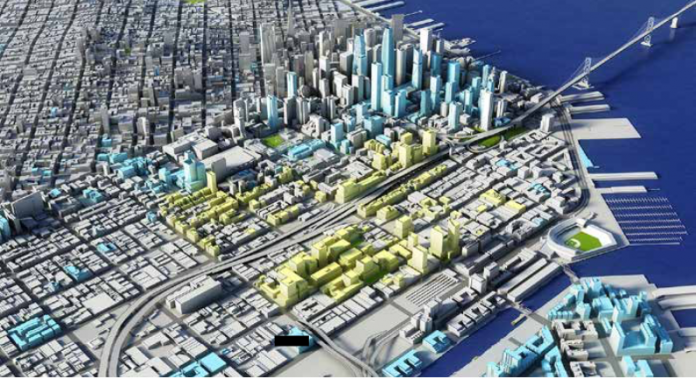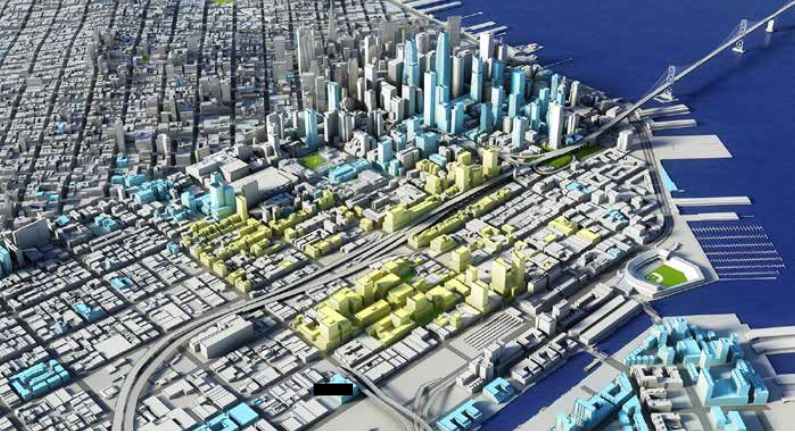
The SF Board of Supervisors approved the EIR for the Central Soma Plan Tuesday, despite hours of testimony from Soma residents and activists who said that the plan would lead to displacement, traffic problems, air quality and climate change problems, and the devastation of the existing Filipino community.
Along the way, we got to hear some of the ongoing absurdity of the way the city measures environmental impacts.

What we got in the end was a unanimous vote for a report that many of the supervisors agreed was outdated, limited, and inaccurate. That allows a plan that pretty much everyone agrees perpetuates the jobs-housing imbalance that drives the city’s displacement problem to move forward for approval next month.
Four groups appealed the EIR. Two were representatives of wealthier residents who were concerned about their views and their air quality. The other appeals were filed by the South of Market Community Action Network and the Yerba Buena Consortium.
Angelica Cabande, SOMCAN’s executive director, said her group opposes turning the neighborhood into a second Financial District. “The environmental impact of displacement is clear,” she said. “We need a more thorough and complete understanding.”
David Woo, community development coordinator at SOMCAN, pointed out that the jobs-housing linkage figures the city uses date back to 1997, when the amount of office space per job was much higher. That study needs to be revised, he said.
John Elberling, director of the YBC, showed a map of all the parts of Soma that are built on fill. “The city decided not to discuss seismic issues,” he said. A lot of the buildings in Soma are older and may have foundation issues, he said, “and 50,000 new people in a dense district next to those existing buildings could be life threatening.”
The city could study that problem and develop mitigations, he said – but “the EIR should not be certified until it does this analysis.”
The speakers in support of the appeal made several key points. The process that led to this plan started eight years ago; from the start, the planners focused on allowing more office space.
So when the EIR was done, the study only analyzed options calling for mostly office and limited housing. Now that it’s clear the city needs housing more than office space, the supervisors can add more housing without further environmental study.
Yes, this is nuts.
The influx of new office space is almost certain to lead to displacement: People who work in what will be expensive space will almost certainly be paid more than many of the current residents of the neighborhood, and that will put pressure on existing vulnerable communities.
Then, if current patterns hold true, people who are forced out of Soma will be forced to live far from the city, and commute in – and since public transit from many outlying areas is spotty and expensive, many will have to drive cars.
There’s no question that displacement of working-class people from urban centers leads to more car use and more carbon in the atmosphere.
That’s not even discussed in the EIR.
Nor is the question of how the addition of somewhere between 30,000 and 65,000 new people to the neighborhood will impact traffic – particularly when existing transit can’t possibly handle that load and the fees developers pay for new transit are nowhere near high enough to pay for the need.
Supervisor Hillary Ronen, in one of the more bizarre moments of the hearing, asked why the EIR doesn’t consider the impact of all of the new Uber and Lyft vehicles that will be drawn to an area with so many new jobs and residents. (I would add all of the delivery vehicles, too: The new residents will be ordering stuff from Amazon, Eaze, food-delivery services and other vehicle-based operations.)
The city’s response, from the Planning Department’s transportation analyst Manoj Madhavan: SF analyzed Vehicle Miles Traveled per capita. So as the population of an area grows, the VMT per capita can go down. That means it’s not a significant environmental impact.
But as the population grows, there are going to be more cars on the road, more Ubers and Lyfts and trucks delivering stuff, and they are going to add to air pollution.
Ronen: Even if you know more vehicles will be driving, idling, and impact the air quality you can’t take that into account?
Madhavan: Since the population is going up, the VMT per capita is going down, so it’s not an environmental impact.
Ronen: That’s very confusing.
It’s more than confusing; it’s ridiculous.
Sup. Aaron Peskin asked about seismic safety, noting that he was on the board when the EIR for the Millennium Tower was approved, and when the EIR for the Lennar project at the shipyard was approved. Now the tower is sinking and leaning over, and radioactive material is popping up at the shipyard.
“So I am entering into this with my eyes more wide open than ever,” Peskin said.
City Planning staffer Jessica Range said that the California Environmental Quality Act, which governs EIRs, does not require cities to consider whether it’s dangerous to bring new people into an environment where they might get hurt. The EIR says that there’s no reason to fear seismic issues, because city and state building codes set high standards for new construction.
“We are relying on the California Building Code and the SF Building Code,” Peskin said. This doesn’t give me necessarily a lot of confidence.”
Given the Leaning Tower of Soma, that’s a reasonable position.
Then there’s the jobs-housing balance. The city decides what fees to impose on office developers based on how many new workers their projects are likely to bring to town (and thus the need for new housing). But that nexus was developed in 1997 – when office space was radically different than it is today. There are probably at least twice as many workers per square foot as there were 20 years ago – and yet, the city bases its analysis on what everyone agrees is, in planning terms, ancient history.
Sup. Sandra Fewer raised an obvious question: Where are the kids of all these new residents going to go to school? City Planning: We are working with the school district on that.
The overall reason that the planning department wants this proposal is, as planner Lisa Chen told the board, the existing zoning, which includes a lot of industrial areas, doesn’t bring in enough money to pay for the improvements the neighborhood needs. So those blue-collar jobs have to go to make room for tech offices (even though there is nowhere near enough housing in the city for the new tech workers, and we have been through this before, and it has been a nightmare for existing residents).
Sup. Jane Kim, who represents the district, said she wanted to see the planners start right away on a new supplemental EIR that would address the need for more housing. She also said that Soma is one of the few areas that can accommodate more job growth, and that other parts of the city have to accept more housing, too.
“Everyone is concerned about the jobs-housing balance,” she said.
Kim told me tonight that it’s possible for the Planning Commission and the supes to add more housing to the district.
I still don’t understand why it’s a priority for the city to attract even more office jobs with even more intense development in a neighborhood already under immense pressure. But the EIR was approved 10-0.
Now the plan goes forward, and in a few weeks the supes will decide to accept a rezoning that will create a new downtown – in a place where vulnerable communities already live.


